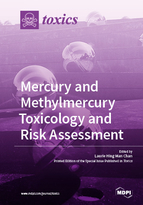Mercury and Methylmercury Toxicology and Risk Assessment
A special issue of Toxics (ISSN 2305-6304). This special issue belongs to the section "Toxicology".
Deadline for manuscript submissions: closed (31 August 2018) | Viewed by 49666
Special Issue Editor
Special Issue Information
Dear Colleagues,
Mercury (Hg) is a global pollutant that affects human and ecosystem health. Wildlife and humans are exposed to Hg primarily through diet in the form of methylmercury (MeHg), since MeHg bioaccumulates and biomagnifies in the food web. Among Hg species, MeHg toxicity is much more damaging to the nervous system in early developmental stages as it leads to alterations in its structure and function. Even at low doses, prenatal exposure to MeHg can disrupt fetal brain development. Since the initial identification of MeHg poisoning in Minamata, Japan, in 1956, the clinical neurology and neurotoxic effects of MeHg have been widely studied. However, the mechanisms responsible for MeHg-induced changes in neuronal function, particularly the delayed effects observed when exposure occurred during fetal development, are not fully understood. Increasing epidemiological evidence is showing that MeHg exposure is also a risk factor for cardiovascular diseases but the toxicological evidence is scarce. Recent advances in toxicology using “omics” approach provide new tools to study the complex effects of MeHg on system biology. Effects of MeHg on stem/progenitor cells show great promise in understanding MeHg toxicology. Increasing understanding of the roles of genetic determinants and the gut-microbiota in determining the toxicokinetics of MeHg also allows for more accurate risk assessment focusing on the sensitive populations. The understanding of interactive effects between Hg and nutrients, such as n-3 fatty acids and selenium, are improving the relevance of risk assessment. This Special Issue calls for papers that report new findings on MeHg toxicology and new information for the improvement of risk assessment of MeHg.
Prof. Laurie Hing Man Chan
Guest Editor
Manuscript Submission Information
Manuscripts should be submitted online at www.mdpi.com by registering and logging in to this website. Once you are registered, click here to go to the submission form. Manuscripts can be submitted until the deadline. All submissions that pass pre-check are peer-reviewed. Accepted papers will be published continuously in the journal (as soon as accepted) and will be listed together on the special issue website. Research articles, review articles as well as short communications are invited. For planned papers, a title and short abstract (about 100 words) can be sent to the Editorial Office for announcement on this website.
Submitted manuscripts should not have been published previously, nor be under consideration for publication elsewhere (except conference proceedings papers). All manuscripts are thoroughly refereed through a single-blind peer-review process. A guide for authors and other relevant information for submission of manuscripts is available on the Instructions for Authors page. Toxics is an international peer-reviewed open access monthly journal published by MDPI.
Please visit the Instructions for Authors page before submitting a manuscript. The Article Processing Charge (APC) for publication in this open access journal is 2600 CHF (Swiss Francs). Submitted papers should be well formatted and use good English. Authors may use MDPI's English editing service prior to publication or during author revisions.
Keywords
- mercury
- methylmercury
- toxicology
- risk assessment
- exposure
- toxicokinetics
- mechanisms







